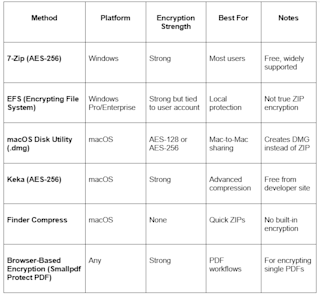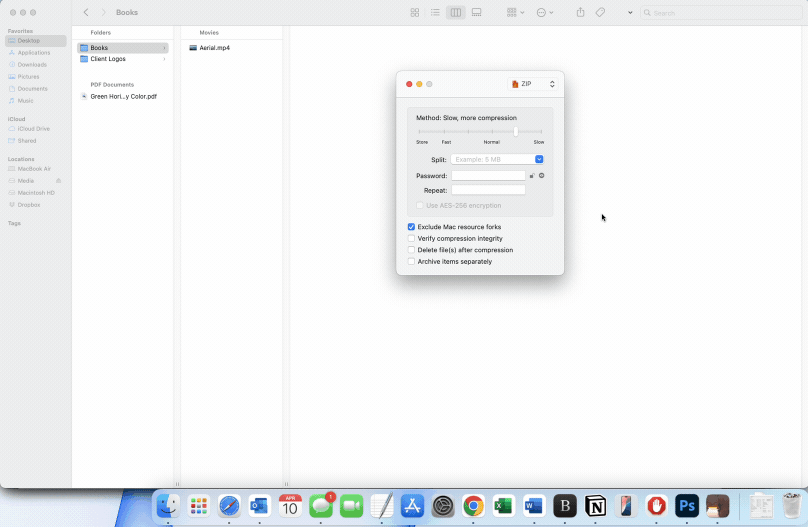
Master ZIP file encryption on Windows and Mac with step-by-step guides using 7-Zip, Keka, and built-in tools to secure your sensitive files.
Encrypting ZIP files is one of the easiest ways to secure groups of documents, photos, or folders before sharing them online.
In this guide, we’ll walk you through every major method:
- 7-Zip on Windows
- Keka on macOS
- Built-in system options
- Encrypted disk images
- Browser-based alternatives
You’ll also find a comparison table, troubleshooting tips, and a clear explanation of what ZIP encryption actually does.
What Is a ZIP File and What Does ZIP Encryption Do?
A ZIP file is a compressed archive that bundles multiple files or folders into a single container using lossless compression. This archive format reduces file size without losing any data, making it perfect for storage and sharing.
When you apply ZIP encryption, the archive becomes password-protected.
Modern ZIP encryption uses AES-256, a widely trusted security standard. AES-256 scrambles your data into unreadable ciphertext. Only someone with the correct password can unlock the archive and restore the original files.
Why ZIP Encryption Matters
Encrypting a ZIP file helps you:
- Protect sensitive files before emailing or sharing
- Meet security and compliance requirements
- Store and archive confidential documents safely
- Reduce file size while keeping the data secure
If you’re exchanging project folders, financial files, medical records, or internal documents, ZIP encryption is a practical layer of protection.
ZIP Encryption Methods at a Glance
Before explaining each method, here’s a quick comparison of the most common ways to encrypt ZIP files.

Comparison of ZIP encryption methods
How to Password-Protect a ZIP File (Windows and macOS)
There are several ways to encrypt a ZIP file depending on your operating system. Even if you’re using Windows or macOS, you’ve got both built-in options and third-party tools to choose from.
Encrypt a ZIP on Windows With 7-Zip (AES-256)
Windows has a built-in option to compress files, but it doesn’t let you encrypt them. For true encryption, you’ll want a tool like 7-Zip:
- Download and install 7-Zip (it’s free).
- Right-click the file or folder you want to compress.
- Hover over “7-Zip” and select “Add to archive.”
- Under the “Encryption” section, set your password.
- Choose “AES-256” for maximum security.
- Click “OK,” and you’re done!
Now you’ve got an encrypted ZIP file that’s both compressed and password-protected.
Encrypt a ZIP on Windows With Encrypting File System (EFS)
Windows Pro and Enterprise editions include EFS, which can encrypt files and folders.
Follow the steps:
- Right-click the file or folder.
- Choose “Properties.”
- Select “Advanced.”
- Check “Encrypt contents to secure data.”
Important: EFS ties encryption to your Windows user account. If you lose account access, you lose the files. It also doesn’t create an encrypted ZIP, so this method is mainly for local protection rather than sharing.
Encrypt a ZIP on macOS With Disk Utility
macOS doesn’t include built-in ZIP encryption, but you can create an encrypted disk image instead.
Here’s how:
- Open “Disk Utility.”
- Go to “File” > “New Image” > “Image from Folder.”
- Select your folder.
- Choose “AES-128” or “AES-256” encryption.
- Save to generate a .dmg file.
This creates a .dmg file rather than a standard ZIP file, but it’s equally secure and works great for Mac-to-Mac sharing.
Encrypt a ZIP on macOS With Keka (AES-256)
Mac users can quickly compress files using the built-in compression option in Finder:
- Right-click a file or folder in Finder.
- Select “Compress” from the dropdown.

Using Keka on macOS to ZIP and encrypt a file
Like with Windows, this doesn’t encrypt the file. To do that, you can use third-party tools like Keka, which allows you to encrypt a ZIP file with a password using AES encryption. Here’s how:
- Install “Keka” from the developer’s site.
- Open Keka and choose “ZIP” format.
- Enter a password under the encryption field.
- Drag your files into Keka’s window to create the encrypted ZIP.
Keka is free if downloaded from the developer’s website and also allows you to select the compression file format, level of compression, or even split super large files.
When to Use ZIP Files and ZIP Encryption
ZIP encryption shines in specific situations where you need both compression and security.
Here are the most common scenarios where encrypted ZIP files make perfect sense:
- Sending large files via email that exceed attachment limits
- Archiving sensitive documents for long-term storage
- Meeting compliance requirements for data protection
- Sharing multiple files while reducing bandwidth usage
- Creating secure backups of important project folders
If you’re only dealing with a single PDF document, direct PDF encryption might be simpler than creating a ZIP file.
Tips for Secure ZIP Encryption and Sharing
Once your ZIP file is encrypted, you’re not quite done yet. A couple of quick checks and good habits can make sure your file stays secure from start to finish.
1. Verify Your ZIP Encryption Worked
Try extracting the file. If you’re prompted for a password, you’re good. Bonus points if you know the tool uses AES-256 or AES 128-bit encryption.
2. How to Open a Password-Protected ZIP File
Double-click the encrypted ZIP file and enter your password when prompted. Most operating systems handle this automatically—Windows uses File Explorer, while macOS uses Archive Utility.
3. Share Securely
Don’t send your password in the same email as the encrypted file. That is equivalent to using “1234” as your PIN, or “password” as you, um, password. Use a different app (like a messaging platform) or share it over the phone.
Here are more security best practices:
- Use strong passwords with 12+ characters, mixing letters, numbers, and symbols.
- Test your encrypted file before sending it.
- Consider setting expiration dates for shared files.
- Keep backup copies of important passwords in a secure location.
ZIP Encryption vs PDF Encryption: Which Should You Use?
You wouldn’t show up for a marathon wearing flip-flops. And when wanting to protect files, it sometimes helps to compare PDF encryption to ZIP encryption.
Choose ZIP encryption when:
- You’re protecting multiple files or entire folders
- You need maximum compression to save storage space
- You’re working with various file types (images, documents, spreadsheets)
- You want a single archive for project files
Choose PDF encryption when:
- You’re protecting a single document
- You want built-in viewing without extraction
- You need digital signatures or advanced permissions
- You’re sharing documents that recipients will view frequently
Alternative: Protect a PDF Directly in Your Browser With Smallpdf
If you’re working with a PDF and want to compress it before encrypting it, use Smallpdf:
- Upload your document to Compress PDF.
- Choose “Basic” or “Strong compression.”
- Wait for the compression to complete, but don’t download the file.
- Look for “Or continue in” below the “Download” button.
- Click “Show more” then look for the “Protect” option.
- Add a strong password, then hit the “Protect” button.
- Download your compressed and secured PDF.

Compressing a document using Smallpdf before encrypting the same file
It’s a smooth way to combine document compression and security. That way, you don’t even need to ZIP it.
Frequently Asked Questions
Is there a way to encrypt a ZIP file?
Yes. Use 7-Zip on Windows or Keka on macOS to create an AES-256 encrypted ZIP. macOS Disk Utility also lets you create encrypted disk images.
How good is ZIP file encryption?
When created with AES-256, ZIP encryption is strong and trusted. Older ZIPCrypto methods are weaker, so always choose AES-based encryption.
How to encrypt 7-Zip files?
Open 7-Zip, choose “Add to archive,” enter a password, and select “AES-256.” This applies strong encryption to the ZIP or 7z archive.
How to make sure a ZIP file is safe?
Test extraction. A password prompt confirms encryption. Use strong passwords and avoid sharing them through the same channel as the file.
What are the security issues with ZIP files?
Older ZIPCrypto encryption is outdated. Poor passwords, corrupted archives, and weak extraction software can also reduce security.



